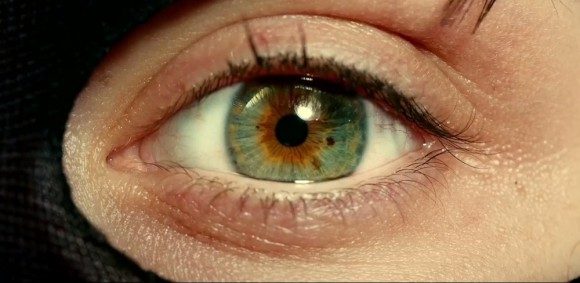What makes eyes so striking? What earns them the moniker, “The Window to the Soul?” Are no two iris patterns alike? Writer-director Mike Cahill (Another Earth) ponders the significance of the two visual orbs in his second feature, I Origins. Once again, Cahill uses a science fiction backdrop to take viewers on a metaphysical and spiritual journey that appreciates the intellectual components of science-fiction, even if it doesn’t connect as well as his previous endeavor.
Ever since he was a child, Dr. Ian Gray (Michael Pitt, Hannibal, Boardwalk Empire) has been obsessed with the iris – the world within the eye that makes each person unique among the billions who have ever walked this Earth. While our fingerprints and ears are also individualized, they don’t come close to replicating the magnificence of the eye. It’s exactly these romantic ideas that make evolving an eye in a lab such a fitting challenge for Ian, who is an atheistic PhD student seeking to disprove the apparently popular theory among creationists that the complexity of the eye proves that God exists. He partners with first year grad student Karen (Brit Marling, The East, Sound of My Voice) who shares his dedication to fact-based truth. However, Ian falls for the mildly eccentric and reincarnation-believing Sofi (Astrid Bergès-Frisbey, Pirates of the Caribbean: On Stranger Tides) due to her remarkable eyes and free spirited nature. Following a tragedy, the movie jumps ahead nearly a decade and places Karen as the primary influence in Ian’s life when a chance discovery regarding the supposed distinctiveness of iris patterns causes a philosophical crisis that forces them both reconsider their own blindness towards religion and even reincarnation.
With I Origins and Another Earth (which was co-written by and starred Marling), Cahill establishes himself as one of the few filmmakers working today who enjoys using science-fiction concepts to explore personal drama and existential questions of self. Cahill’s script never seems to be merely a hodgepodge of random ideas for the sake of surface-level complexity (I’m looking at you Transcendence); rather, it feels as though he put genuine thought into both the science and the implications of the ideas he’s exploring. The catalysts in these films are world-changing, but he tries not to lose sight of the lives being thrown into turmoil. He ponders how people would react upon learning that iris patterns may be shared between the dead and the living, and posits issues related to the possibility of reincarnation and memory retention. Wisely, Cahill doesn’t choose sides in the spirituality vs. science debate and subscribes mostly to the belief that keeping one’s mind open to all possibilities is the true key to understanding our universe.
As with Another Earth, I Origins remains centered on the individual’s sense of self in the face of scientific advancement, but attempts a lot more conceptually – for better and worse. The second half of the movie and its concentration on iris patterns does not sync particularly well to the first half’s eye growing experiment, which is disappointingly dealt with in what amounts to a throwaway sequence. Yet despite this mid-point changeover, I Origins remains consistent with its themes and tone so that it doesn’t come across as particularly off-putting. Cahill’s dark and broody style mixes well with his small-scale/large stakes approach to create a consistent and powerful sense of claustrophobia, pensiveness, insecurity, and even hope.
Cahill’s skills as a director, idea generator, and atmosphere builder help overcome the movie’s flaws, which is most evident with its characters. As the protagonist, Dr. Ian Gray fares well enough because he is undergoing the most personal journey, and Cahill knows how to use him as the main vehicle for the film’s underlying conceptual debates. But the two women are given very underwritten parts. Although one is more spiritual and the other more scientific, they are both overly doting and subservient to Gray. At times, they seem only exist to satisfy his whims and curiosity, and even their challenges seem more about the film’s need for a devil’s advocate mouthpiece than utilizing the women as true foils, or giving them points of view of their own.
Thankfully, the actors are able to rise above the failings of the screenplay. Generally cast as somewhat of a sociopath, Pitt successfully plays against type as a sympathetic, heartfelt character whose scientific fervor seems to come more from a passion for discovery than from being obsessed with putting intelligent design advocates in their place. Pitt instills Gray with a humanity and pain that is rare in most instances where the scientist plays God (I’m looking at you, again, Transcendence). Despite being relegated to the parts of “fantasy women,” Bergès-Frisbey and Marling manage to force some personality to their parts by giving a soulfulness to Sofi’s “manic pixie dream girl” and letting Karen feel like a partner to Ian rather than merely his assistant. Of course, there’s a minor love triangle subplot between the three, but it resolves itself relatively simply, which actually ends up strangely problematic. Love triangles may be played out as a narrative device, but Karen overcomes her jealousy and concerns in a single line. It’s definitely preferable to a drawn out melodrama, and yet doesn’t feel wholly satisfying, either – which is also an apt description for the movie itself.
The Verdict: 3 out of 5
Interesting concepts, a haunting atmosphere, and even good performances cannot entirely overcome poorly drawn characters, occasionally blatant points, or a mid-stream change in focus. I Origins might not be as thought-provoking as it thinks it is, but it respectably asks questions (and invites the audience to think about them) rather than merely vomiting up ideas or giving out easy conclusions. Despite its issues, writer-director Mike Cahill’s understated, cerebral take on science-fiction serves as a welcome alternative to this summer’s studio and independent fare.




